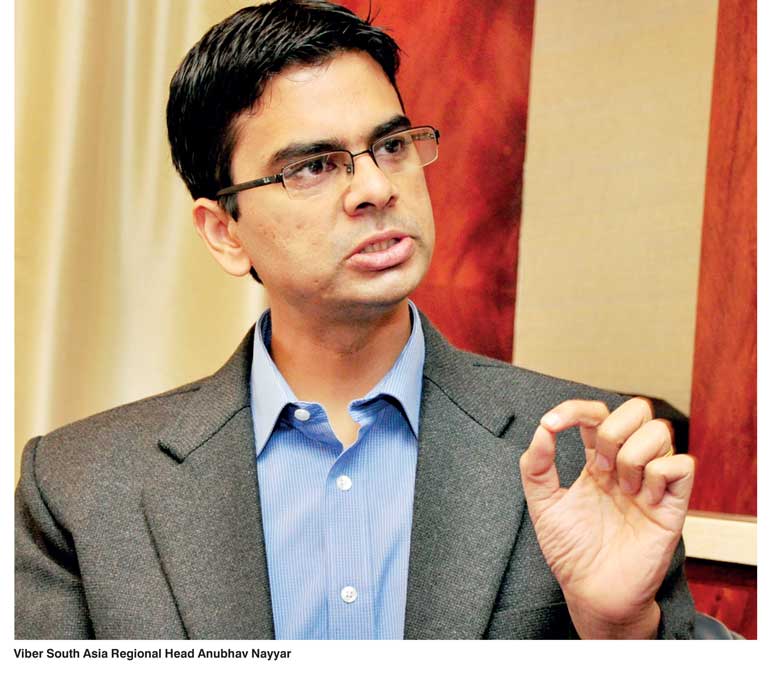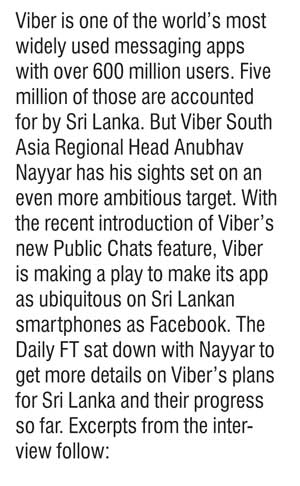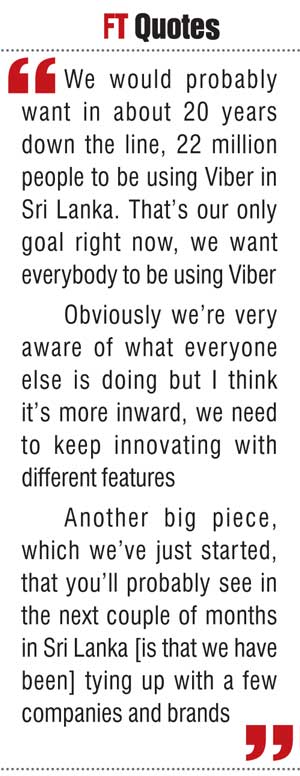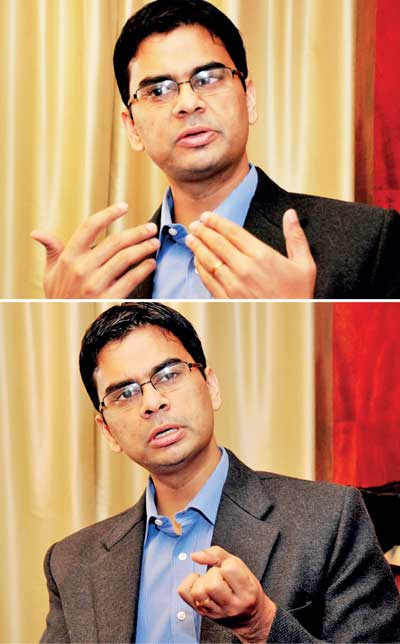Wednesday Jul 16, 2025
Wednesday Jul 16, 2025
Thursday, 11 February 2016 00:00 - - {{hitsCtrl.values.hits}}

By Madushka Balasuriya
 Q: So this is your first visit to Sri Lanka. Tell us a little bit about why you’re here?
Q: So this is your first visit to Sri Lanka. Tell us a little bit about why you’re here?
A: Well I’m here for a couple of things. Public Chat is something we launched a while back, so we’re always looking at partners, etc. The basic purpose is obviously, one, to understand the Sri Lankan market – it’s a big market for us – and in addition to that we’re also looking at certain partnerships with various companies and corporates. Also certain personalities and, you know, different sorts of partnerships. That’s the main purpose of coming over here.
Q: Viber is fairly widely used in Sri Lanka now, but how important is it for a company like Viber to get into markets like Sri Lanka early?
A: I think it’s very important because people generally adapt to these services really fast and what we have seen, not only in Sri Lanka but across all of our other markets, is that apps which start off early do tend to do really well. It’s very important for us also to constantly innovate because there could be someone sitting in a garage out there creating products as we speak. So it’s important for us also, that it doesn’t end at entering a market early. You need to constantly innovate and look at different things that you can offer.
Whether it’s WhatsApp or all the other messaging or calling apps out there, I think there are a lot of similarities in their core services; they’re all communications platforms. That’s completely understandable, and that also allows a space for both. The Sri Lankan market is a good example of this. Both platforms are doing really well and we’re aware of that. But I think the point is, what more? Being a messaging and calling platform has been there for the last two to three years, what more? What other needs can you sort of fulfil, whether it’s for a particular user or for businesses?
Q: As far as the SL market goes, what have you identified as its needs?
A: One of things we’ve seen that is different in the Sri Lankan market – and this is our educated guess – is that it’s a country which really wants to express itself. This basically comes from the fact that we’ve seen our Sticker usage and Public Chats to be very high, specifically Sticker usage. I can roughly tell you one out of two users use Stickers on a daily basis, which is phenomenally high when compared to other countries. We’ve normally seen across other markets, that one of the reasons for that is that people are not just sticking to basic text messaging but are more expressive and want to share different emotions, different purposes. So from the user aspect we have seen that localisation will really, really help and that’s something which I haven’t seen too many apps or products do over here.
The second aspect is that purely based on the number of requests we’ve received from organisations, Government bodies and companies, this shows that there aren’t too many companies who offer the type of service we offer and try to integrally partner with local businesses. It’s not necessarily ever about, “okay we’ll do a partnership and X number or rupees is what we’ll make out of it,” but more about whether we can partner a company and together fulfil a particular end need or possibly a campaign, or fulfil a particular mission maybe that the country or government has decided to undertake.
Q: Public Chats is a way by which Viber can partner with local companies. Can you elaborate a bit on that?
A: Public Chat is a platform where, whether it’s celebrities, groups, companies, government bodies, college students, it could be any set of people who are having their conversations, exchanging information, exchanging behind-the-scenes stuff, and it’s almost what we call a ‘fly-on-the-wall’ experience. We’ve just started things over here but I’ll give you a few examples globally of what we’re doing.
A few platforms like Mashable and BBC are available on Viber Public Chats globally. So that’s typically media houses or digital media houses who are exchanging and sharing information, but you never actually get to know what journalists thinks and their views on trending topics. So we have 10-15 journalists or writers who are actually talking about daily things, interesting things that they find. So it’s for the first time a behind-the-scenes view of what we normally see. A person like me, when I interact with a journalist I see what the person has written in the newspaper, but I really don’t get their opinion on different, different trending topics, so that’s one example. 
The other example could be…for example in India, we have a group of about 15 people who go to movie launches, music launches. They provide behind the scenes moments, candid interviews, videos, pictures of what goes into making the event. As a user of Viber, I can view all these things and as time passes, obviously we’re continuously developing the product, we will reach a stage where the public can interact with that group.
Q: So these companies, are they predominantly going to be using Viber for marketing or as a service?
A: I think it will be a bit of both. I would first start with providing it as a utility, where people can use it as a platform to achieve their objectives. It sounds really nice, and it is. As you know Viber is a completely free app, and that’s how it works for all companies as well; a company is pretty much like a user for us. So the first idea is to always provide it as platform.
For example, it could be a hotline. Say a company wants to get in certain entries, wants to have a phone number where they’re readily contactable? As a messaging service we provide that. There is no charge, it is completely free, but obviously it’s a tie up we have with the company. That’s one direction. But then there will always be a direction where a company can look at some sort of a space in which they can make their own company popular on the app. Not through direct advertising but through some sort of integration with the product. So it purely depends on the kind of service we’re looking at.
Q: Viber has been free since its inception. How challenging is it to monetise it in the South Asian market and, more specifically, in Sri Lanka?
A: Sri Lanka is a market which predominantly looks at services which are free. And I think it’s a trend which is similar to the whole of South East Asia, whereas in a lot of countries like the UK, US or Russia, we’ve seen that the amount of money that people are willing to pay within an app is far higher. But that doesn’t mean we’re not monetising.
Let’s stick to Sri Lanka. Currently our two sources are Viber Out and Stickers. Viber Out is where you use Viber on your mobile, buy credits through a debit or credit card, and you can use your Viber connection to call any number anywhere in the world at a very subsidised rate. The rates vary from country to country but they’re on our website. So we see a lot of monetisation happening there because it’s a clear value benefit being provided to everybody. We do see some revenue coming through stickers in Sri Lanka as well.
We’ve also been – and this is another big piece, which we’ve just started, that you’ll probably see in the next couple of months in Sri Lanka – tying up with a few companies and brands. They will be looking at partnering, whether it’s in terms of Stickers or in terms of Public Chats, of providing their brands, and we’ll look at integrating it very nicely. Not advertising, but perhaps look at branded stickers.
Q: Could you tell us about some of the brands you’ve tied up with in Sri Lanka?
A: It’s still under wraps at the moment. But let me put it like this, which you will see in the next couple of months, it’s a healthy mix between some very local Sri Lankan players and also some multinational corporations based out of Sri Lanka.
Q: The industry Viber is in is becoming increasingly competitive. What is your plan to stay ahead of the market?

A: Viber is eventually a communication platform, and we would never look at it as a feature to feature comparison. Because then it becomes a case where you find five other players out there who are offering a service which is very, very similar. I think our philosophy is not really to look at competition, and therefore innovate accordingly.
Public Chats when it was launched was, and is still, fairly unique in its way. And it wasn’t really to counter anything, it was just sort of an evolution that we were looking at. So it won’t ever be that we’re just looking at tackling a Snapchat or WhatsApp, it’s just that we’re constantly looking to innovate, and provide experiences which are just slightly different.
If on a scale of 1-100, if our competitor is providing something that is 80 and maybe three months later we try to provide the same experience at 85, people aren’t necessarily going to move to us because there just use to that first experience already. Obviously we’re very aware of what everyone else is doing but I think it’s more inward, we need to keep innovating with different features.
Q: What is Viber’s long-term goal?
A: We would probably want in about 20 years down the line, 22 million people to be using Viber in Sri Lanka. That’s our only goal right now, we want everybody to be using Viber.
Q: And if all 22 million are using it but not paying for the service, that’s fine?
A: It’s okay. Let me put it like this, this is an industry of percentages. There’s always a stage of evolution that happens. For us, our only goal – and obviously goals also tend to vary from a global perspective, by countries – currently is that every Sri Lankan out there is using our app, it’s as simple as that. That’s why even in this entire conversation you wouldn’t have heard too much about monetisation. We want everyone Sri Lankan to use it, and that’s our goal as of now.
Obviously it’s still a business and money has to be made, and money is made. To give you a very simple statistical logic…we have approximately 615 million users globally. Even if today even 0.1% of those people look at monetising and we get one dollar out of them we’re talking of approximately 6-10 million dollars straight away. What I can say is that it’s not so small. This is obviously a very worst case scenario. Different people, different countries, different needs.
Whether it’s Viber Out, whether it’s Stickers, whether it’s partnerships, there are sources of earning revenues but I think the best thing is that when this company was formed in 2010 there was a line which is still there, ‘Viber connect freely,’ which is part of our logo and that is pretty much what we stand for. We stand for connecting freely. It’s always been free and we’ll continue to do that.
Pix by Lasantha Kumara
Discover Kapruka, the leading online shopping platform in Sri Lanka, where you can conveniently send Gifts and Flowers to your loved ones for any event including Valentine ’s Day. Explore a wide range of popular Shopping Categories on Kapruka, including Toys, Groceries, Electronics, Birthday Cakes, Fruits, Chocolates, Flower Bouquets, Clothing, Watches, Lingerie, Gift Sets and Jewellery. Also if you’re interested in selling with Kapruka, Partner Central by Kapruka is the best solution to start with. Moreover, through Kapruka Global Shop, you can also enjoy the convenience of purchasing products from renowned platforms like Amazon and eBay and have them delivered to Sri Lanka.
Discover Kapruka, the leading online shopping platform in Sri Lanka, where you can conveniently send Gifts and Flowers to your loved ones for any event including Valentine ’s Day. Explore a wide range of popular Shopping Categories on Kapruka, including Toys, Groceries, Electronics, Birthday Cakes, Fruits, Chocolates, Flower Bouquets, Clothing, Watches, Lingerie, Gift Sets and Jewellery. Also if you’re interested in selling with Kapruka, Partner Central by Kapruka is the best solution to start with. Moreover, through Kapruka Global Shop, you can also enjoy the convenience of purchasing products from renowned platforms like Amazon and eBay and have them delivered to Sri Lanka.